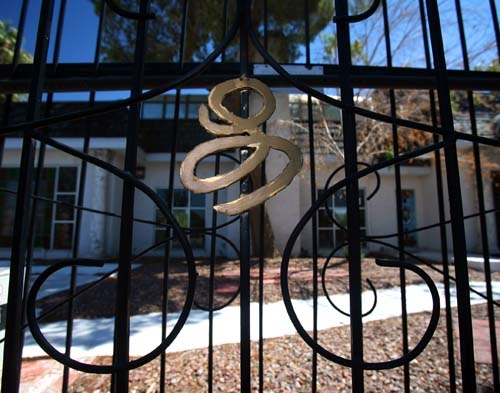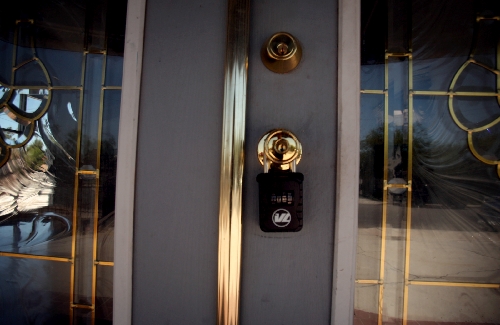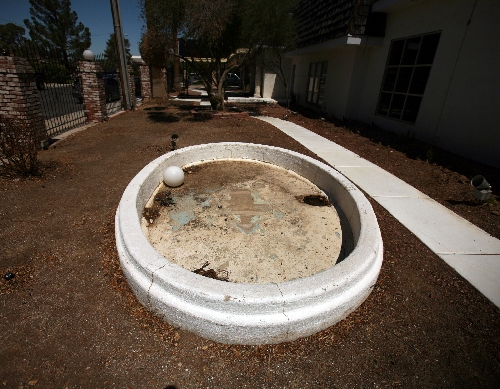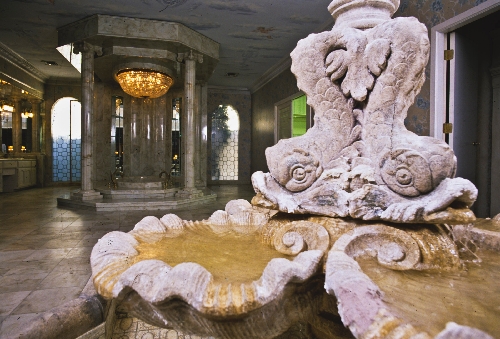Las Vegas housing collapse saw many, many casualties
You are a loser, and so am I.
Everyone lost something when the Southern Nevada housing market caved in five years ago.
Mostly what we lost was money - almost $113 billion of it, according to a rough estimate by a top real estate expert at the University of Nevada, Las Vegas.
But the sharp drop in housing values also wiped out tens of thousands of jobs in construction, real estate, finance and related fields. Houses were lost, college funds erased, retirement plans scuttled.
Those who managed to escape the financial carnage unscathed - renters and lucky latecomers here to take advantage of one of the most favorable buyer's markets in the region's history - found themselves in neighborhoods dotted with vacant homes, empty storefronts and the dingy sheen left by neglect and indifference.
Even now, those paid to track such things - people such as Jeremy Aguero, principal analyst for the research firm Applied Analysis - seem surprised by the severity of the collapse.
A recent analysis by Aguero's firm, performed at the Review-Journal's request, illuminates the nauseating drop in home values and where it was felt the most: namely in older, established and, in many cases, poorer neighborhoods.
As Aguero put it, "Those with the least to lose lost the most."
But identifying the market's biggest losers is a bit more complicated and subjective.
A good place to start is the month when prices reached their peak. Two months, really: October 2006 for existing homes and August 2007 for new homes.
Not everyone who bought at the peak lost big, and not everyone who lost big bought at the peak.
Generally, though, it is safe to assume that homes purchased when prices were at their highest now rank near the top in terms of lost value.
So, for the purposes of this exercise, we asked Applied Analysis to take all the existing home sales recorded in October 2006 and all the new home sales recorded in August 2007 to try to figure out what happened to those properties in the turbulent years since.
Here's what Aguero and company found:
■ Existing homes lost more value than new ones. Of the roughly 3,000 existing homes bought in the peak month, the median loss was almost $190,000, or 65 percent.
Of the almost 1,900 new homes bought in the peak month, the median loss was more like $182,000, or almost 60 percent.
■ Many of the biggest losers got out quick, though not necessarily by choice. Among the sales recorded during the two peak months, 63 percent of existing homes and 43 percent of new homes have since been resold at least once.
If you bought new at the peak, your chances of losing your home to foreclosure were about one in four.
If you bought an existing home at the peak, your chances of foreclosure were closer to 50-50.
But that's not what jumps out at Jake Joyce, senior manager for Applied Analysis. He is struck by how many of the properties are still in the hands of the original owner.
"Some of these, I wonder why they haven't walked away," he said. "It's pretty surprising."
■ Losing takes on many forms. Sort by the percentage of value lost, and the top of the existing-home list is crowded with modest single-family houses while the top of the new-home list is awash in condo units.
Sort by the sheer dollars lost, and the two lists are topped by the mansions of Vegas royalty, one a recent Player of the Year from the World Series of Poker, the other Liberace himself.
Those two properties alone have declined in value by a combined total of almost $5.9 million dollars in less than six years.
■ ■ ■
Of the roughly 3,000 existing single-family homes sold during the market's peak month, none has lost a greater percentage of its value than the one at 1424 Lawry Ave.
The unremarkable 1,044-square-foot house is worth about 90 percent less now than when it sold in October 2006 for an eye-popping $212,000, only to sink into foreclosure less than a year later.
The home sits on a poor street in a poor neighborhood near Martin Luther King and Lake Mead boulevards.
It shares Lawry Avenue with several homes built for low-income families by Habitat for Humanity.
But the current owners couldn't care less about its decline in value. Joe and Rita Schlageter snapped the place up in late 2008 for just $15,000, adding it to the list of dozens of valley homes the couple has bought, rented out and sold since 1962.
"We've been buying and selling houses for 50 years, and they've been going up and down and up and down," Schlageter said. "We probably won't live long enough to see them go back up again."
The husband and wife have made their living - and spent the bulk of their lives - in the Las Vegas rental market. He maintains the properties, and she maintains the books and other paperwork.
"It's a seven-day-a-week, 24-hour-a-day job," she said. "Joe always likes to buy stuff that looks like a bad day in Beirut and fix it up."
So far, the Schlageters are up about $5,000 on their Lawry Avenue investment, at least based on its current fair market value estimate of just more than $20,000.
The notion of a house like this selling for more than $200,000 "sounds a little ridiculous" to Schlageter, but so was a lot of what went on during the run-up to the collapse.
"There were so many stupid things going on. It's amazing the world survived," Schlageter said. "I kept saying this can't go on. It doesn't take a genius to figure that out. It just takes a little common sense."
So, what were Joe and Rita Schlageter doing back when prices were surging?
That's easy, she said. "We were selling things."
■ ■ ■
Plot the peak sales on a map and color-code them by the value they have lost and what you get resembles what might happen if a volcano erupted somewhere near the Spaghetti Bowl.
The dark red of losses topping 75 percent spread like lava through the older neighborhoods that bracket Interstate 15 and U.S. Highway 95 in the central valley.
The worst of the devastation lies west of I-15 and north of Tropicana Avenue, while newer, more affluent areas to the south and west largely sport the cool greens and blues of losses under 50 percent.
Most of the valley's east side glows bright red, and the hottest colors flow south from there along the line of Boulder Highway to spill into the heart of old Henderson. Patches of red also bracket the Strip and I-15, marking the locations of high-rise condo developments crushed flat by the economic implosion.
Aguero calls it a heat map. What it documents, he said, is the enormous damage inflicted on what was, at least until recently, "the single most important way a middle-income family accumulates wealth."
"I don't think anyone can look at that map and not be startled by the magnitude of the loss," Aguero said. "I think we've all lived through one of the most difficult times in Southern Nevada's history."
As Joyce notes, even the least affected areas took a hit of 20 percent or more. No address was completely spared.
"There was no pocket of prosperity or recession-proof neighborhood. No neighborhood, no income class, housing sector," said Joyce, who watched as his own parents were forced to short-sell their house just as they approached retirement age. "We've all been affected."
Aguero expects what happened here to define a generation.
"This was our Great Depression, right?" he said. "It will change buying behavior, change the way people plan for retirement, change the way people buy their first home. It will change the way people do what they do. Everything."
■ ■ ■
So there it is then: If you bought in Southern Nevada between, say, 2002 and 2009, your home is almost certainly worth significantly less now than it was then. And every homeowner in the valley who bought before the market bottomed out has seen at least some value drained from what is, for most Americans, the largest investment they will ever make.
But just because we're all in this together does not mean anyone is eager to talk about it publicly.
Over the course of several months, the Review-Journal reached out to more than 100 homeowners, nearly all of them facing foreclosure. Most ignored our inquiries or flatly declined to be interviewed. In a handful of cases, people agreed to sit down with us only to back out at the last minute.
One woman whose small home in Henderson has lost close to 90 percent of its value since she bought it almost six years ago got cold feet just a few hours before her scheduled meeting with a reporter.
In an apologetic text message she wrote: "It's kind of a painful subject right now, and I don't really want my friends and family reading about it, if that makes sense."
Businessman and professional poker player Frank Kassela did not respond to calls and emails from the Review-Journal.
The World Series of Poker named the 44-year-old its Player of the Year for 2010 after he won two events and cashed in four others, raking in almost $1.26 million. All told, Kassela has pocketed more than $2 million in tournament poker since 2003, but so far he has lost big on one huge bet he made in August 2007.
That's when he bought a new 10,600-square-foot mansion behind a guard gate in the exclusive Spanish Hills neighborhood overlooking Tropicana Avenue and the Las Vegas Beltway. His $4.35 million investment has since lost more than two-thirds of its worth, according to Clark County's estimate of its current fair market value.
In the county assessor's eyes, Kassela's property on Scenic Ridge Drive is now worth about $1.36 million, the largest decline of any valley home, new or old, bought at the peak of the market.
It's also for sale, as are the mansions on either side of it.
If you can get through the gate at Spanish Hills and stand on Scenic Ridge Drive facing the homes, the one on the far left is priced at $4.5 million, the one on the far right at $3.9 million, and smack in the middle is Kassela's place. It's currently listed for $4.25 million, $10,000 less than the poker player paid for it.
■ ■ ■
American dreamers and greedy speculators weren't the only ones buried in the rubble of the housing collapse.
The valley's third-biggest loser in raw dollars - and second biggest among existing homes - is a 4,000-square-foot house on more than five acres of horse property down the street from Wayne Newton's Casa de Shenandoah.
In October 2006, it sold for $3.1 million to the Paul E. & Helen S. Meyer Foundation, a charitable organization that backs a variety of local causes from medical research to college scholarships. Public television viewers may recognize the foundation - and its namesakes - from the photograph showing a kindly old couple that accompanies its sponsorship of local programming.
The people in the picture are Amy Meyer's late grandparents. She now carries on their work as president of the Meyer Foundation.
She said the foundation bought the property near Pecos and Sunset roads for a new venture she was spearheading called White Horse Youth Ranch, a faith-based program to help young victims of bullying and other disadvantaged children find new confidence through hands-on work with horses.
At the time, 3505 E. Maule Ave. looked like an ideal location, and even at 2006 prices it seemed like "a smoking deal" compared with other ranch properties in the valley, Meyer said.
It wasn't until later, when neighbors complained and county permitting officials balked, that the foundation realized it had paid more than $3 million for something it could not use.
Since then, WHY Ranch has been operating with borrowed horses at several "host properties" around the valley, and the foundation has found renters for its unfortunate investment on Maule Avenue.
Meyer said they don't have the money to buy another site someplace else.
But unlike other local homeowners, the foundation can afford to be patient. Meyer and company paid for the property in cash, a luxury that insulates them from default and allows them to wait for prices to rebound.
Current estimates put the fair market value at less than $820,000.
"Unfortunately, we own it. It's ours," Meyer said with a laugh. "If someone wants to come take it off our hands, they're certainly welcome to. Or if someone wants to donate a beautiful piece of property for us, that would be great too."
Ultimately, Meyer is just happy WHY Ranch has been able to survive and grow, despite what she now charitably refers to as her "learning experience."
"It's affected so many people," she said of the housing collapse. "At least in our case, I can say we came out victorious."
■ ■ ■
The valley's biggest cash loser, at least among existing homes, is an address best known for the long-dead man who lived there more than two decades ago.
But calling this a house is like describing Liberace as some guy who played piano.
At just less than 15,000 square feet, the flamboyant singer's villa bulges from two lots in a fading neighborhood of modest ranch-style homes directly across Tropicana Avenue from the Thomas & Mack Center.
By the time Terrance Dzvonick bought it for $3.7 million in October 2006, 4982 Shirley St. had long since ceased to be a home.
Dzvonick's plan was to run it the same way it had been for more than a decade: as a wedding and banquet facility with a colorful and well-appointed backstory.
But he quickly ran afoul of the county and his neighbors over issues of parking and access.
He eventually lost his permit to have events at the site and with it any chance to make his monthly mortgage payment.
"They put me out of business. They put my employees out of business," said Dzvonick, who lived at the house with some of his workers for several years.
JPMorgan Chase foreclosed on the mansion in 2010.
Today the house looks like a lot of other bank-owned properties in Las Vegas: a narrow front yard reduced to bare dirt. An empty concrete fountain. Curtainless windows looking in on stark, empty rooms - albeit ones lined with marble floors, mirrored walls and chandeliers.
The property sits behind an ornate, black metal fence marked here and there with cursive L's coated in faded gold paint, but the gates are flung wide open, adding to the feel of abandonment.
The air vibrates with take-offs and landings from nearby McCarran International Airport. Otherwise, the corner of Shirley Street and Radkovich Avenue is largely quiet.
At the moment, Liberace's mansion is not for sale. Dzvonick has seen to that.
He has been fighting the foreclosure action ever since it was filed, largely on grounds now common to such proceedings - that the bank cannot produce the original note for the property.
The federal lawsuit he filed more than two years ago remains active, but even he admits the battle is almost at an end.
"They've got all the money in the world to fight me. I'm fighting super-duper attorneys who know a lot," said Dzvonick, who is serving as his own attorney but mostly makes his living these days by buying and selling foreclosed homes. "It's one in a million I get it back."
Even if he doesn't, he still thinks the property and its history have profit potential - especially at its current estimated value of roughly $800,000.
Dzvonick is convinced someone will eventually buy it and fix it up, though it won't be cheap. He said the roof is shot and the house may have mold problems. He figures it needs about $250,000 in repairs, not counting what it might cost to refurnish and decorate the place in a manner befitting the original king of bling.
Others are less optimistic.
Jack LeVine is a local real estate broker who specializes in the valley's core neighborhoods and historic addresses.
He said very little of value is left of the mansion or its legacy. The structure has almost no remaining appeal as a residence, and its marketability as a business is limited by its condition, the lack of on-site parking, the lingering objections of neighbors and the waning popularity of Liberace himself.
"I seriously doubt it's ever going to go back to something like it was," LeVine said of the mansion. "I can't imagine anything happening to it other than it being bulldozed someday."
■ ■ ■
The findings from Applied Analysis did not shock Nasser Daneshvary.
Two years ago, the director of UNLV's Lied Institute for Real Estate Studies produced a map of his own, one that charted foreclosures by ZIP code.
His map looks like a boxy version of the one produced by Aguero and company. Both show the same intense pockets of economic suffering in the same parts of the valley, but from slightly different angles.
"It was no surprise at all," said the 62-year-old Daneshvary a few weeks before his death on Aug. 18. "The same neighborhoods have the highest number of foreclosed homes."
More foreclosures mean more bank-owned homes sold at auction at bargain basement prices, which in turn drives down the value of the surrounding properties.
Daneshvary said the foreclosure problem has been more pronounced in older, poorer neighborhoods because that's where homes were generally less valuable to begin with and where many homeowners made lower wages in less-secure jobs.
"Most owners could not afford the mortgage payments when the economy went south, and at the same time their adjustable mortgage rates became due for reset," he said.
Some of the people caught by the collapse were investors snapping up homes in hopes of flipping them for a quick profit. But most of the victims were average, first-time buyers who took the plunge at exactly the wrong time, Daneshvary said.
"They were unsophisticated, reactionary buyers who didn't want to be priced out of the market," he said. "I believe everybody is responsible for their own behavior, but we also react to what's going on in our economy. Everybody had access to credit, so everybody was buying regardless of their ability to pay. And everybody was rushing to buy because prices were going up."
In other words, lenders deserve part of the blame. In the run-up to the collapse, the market was a free-for-all without checks and balances, Daneshvary said.
Far more surprising to him was the intensity of the boom.
"It was crazy. I would go to a new neighborhood, and after six months, I wouldn't recognize it anymore," he said. "Because of the heat (in the market), we overbuilt everything."
What remains is a valley saturated with empty commercial office space and seriously depressed high-rise condo developments - two markets unlikely to rebound anytime soon, Daneshvary said.
"The Manhattanization of downtown? (Those high-rises) are not going to come back in Las Vegas for at least 10 years."
He was more hopeful about the market for single-family homes, even in the neighborhoods hardest hit by the downturn.
This time around, the low prices seem to be drawing "investors, not flippers," who are buying up houses, cleaning them up and renting them out, injecting cash and people back into depressed areas, Daneshvary said.
"It's already coming back. We are on the way back, slowly but surely."
With any luck, we learned a few lessons along the way, Daneshvary said.
First, not everyone can or should own a home. And those who do would be wise not to treat it as a quick path to wealth.
"I hope we learned that a home is not a short-term financial investment," Daneshvary said. "It's a long-term investment in family and life."
Contact reporter Henry Brean at hbrean@reviewjournal.com or 702-383-0350.
AWASH IN LOSS: 'Heat map' shows where the housing collapse hit hardest

























